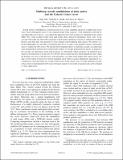| dc.contributor.author | Elor, Gilly | |
| dc.contributor.author | Rodd, Nicholas Llewellyn | |
| dc.contributor.author | Slatyer, Tracy Robyn | |
| dc.date.accessioned | 2015-05-29T18:02:52Z | |
| dc.date.available | 2015-05-29T18:02:52Z | |
| dc.date.issued | 2015-05 | |
| dc.date.submitted | 2015-03 | |
| dc.identifier.issn | 1550-7998 | |
| dc.identifier.issn | 1550-2368 | |
| dc.identifier.uri | http://hdl.handle.net/1721.1/97128 | |
| dc.description.abstract | If dark matter is embedded in a nontrivial dark sector, it may annihilate and decay to lighter dark-sector states which subsequently decay to the standard model. Such scenarios—with annihilation followed by cascading dark-sector decays—can explain the apparent excess GeV gamma rays identified in the central Milky Way, while evading bounds from dark matter direct detection experiments. Each “step” in the cascade will modify the observable signatures of dark matter annihilation and decay, shifting the resulting photons and other final state particles to lower energies and broadening their spectra. We explore, in a model-independent way, the effect of multistep dark-sector cascades on the preferred regions of parameter space to explain the GeV excess. We find that the broadening effects of multistep cascades can admit final states dominated by particles that would usually produce too sharply peaked photon spectra; in general, if the cascades are hierarchical (each particle decays to substantially lighter particles), the preferred mass range for the dark matter is in all cases 20–150 GeV. Decay chains that have nearly degenerate steps, where the products are close to half the mass of the progenitor, can admit much higher dark matter masses. We map out the region of mass/cross-section parameter space where cascades (degenerate, hierarchical or a combination) can fit the signal, for a range of final states. In the current work, we study multistep cascades in the context of explaining the GeV excess, but many aspects of our results are general and can be extended to other applications. | en_US |
| dc.description.sponsorship | United States. Dept. of Energy (Grant Contract DE-SC00012567) | en_US |
| dc.publisher | American Physical Society | en_US |
| dc.relation.isversionof | http://dx.doi.org/10.1103/PhysRevD.91.103531 | en_US |
| dc.rights | Article is made available in accordance with the publisher's policy and may be subject to US copyright law. Please refer to the publisher's site for terms of use. | en_US |
| dc.source | American Physical Society | en_US |
| dc.title | Multistep cascade annihilations of dark matter and the Galactic Center excess | en_US |
| dc.type | Article | en_US |
| dc.identifier.citation | Elor, Gilly, Nicholas L. Rodd, and Tracy R. Slatyer. “Multistep Cascade Annihilations of Dark Matter and the Galactic Center Excess.” Phys. Rev. D 91, no. 10 (May 2015). © 2015 American Physical Society | en_US |
| dc.contributor.department | Massachusetts Institute of Technology. Center for Theoretical Physics | en_US |
| dc.contributor.department | Massachusetts Institute of Technology. Department of Physics | en_US |
| dc.contributor.mitauthor | Elor, Gilly | en_US |
| dc.contributor.mitauthor | Rodd, Nicholas Llewellyn | en_US |
| dc.contributor.mitauthor | Slatyer, Tracy Robyn | en_US |
| dc.relation.journal | Physical Review D | en_US |
| dc.eprint.version | Final published version | en_US |
| dc.type.uri | http://purl.org/eprint/type/JournalArticle | en_US |
| eprint.status | http://purl.org/eprint/status/PeerReviewed | en_US |
| dc.date.updated | 2015-05-26T22:00:05Z | |
| dc.language.rfc3066 | en | |
| dc.rights.holder | American Physical Society | |
| dspace.orderedauthors | Elor, Gilly; Rodd, Nicholas L.; Slatyer, Tracy R. | en_US |
| dc.identifier.orcid | https://orcid.org/0000-0003-2716-0269 | |
| dc.identifier.orcid | https://orcid.org/0000-0001-9699-9047 | |
| dc.identifier.orcid | https://orcid.org/0000-0003-3472-7606 | |
| mit.license | PUBLISHER_POLICY | en_US |
| mit.metadata.status | Complete | |
